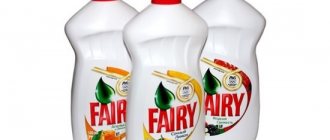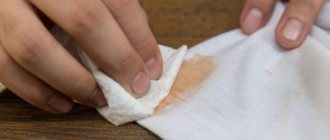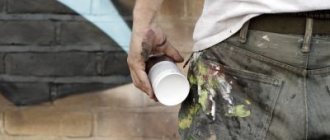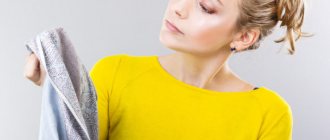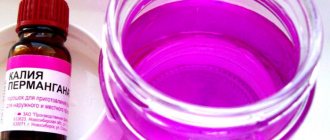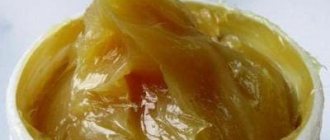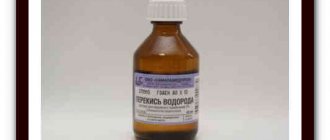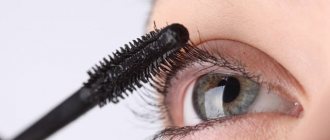Using antiperspirant is more of a necessity than a whim. A person has to move a lot during the day and communicate with different people. Without the use of special products, by the evening the smell of sweat will make itself too obvious. But while solving one problem, we often encounter another. Unsightly stains appear on clothes in the armpit area, which can be seen with the naked eye. There are many options for dealing with pollution: from special products to home methods. It's easier to deal with deodorant stains in hot water - but not every type of fabric will tolerate this treatment.
Why does deodorant not wash off?
The thing is, it's not just pollution. Stains do not occur from sweat getting on clothes, but as a result of chemical reactions catalyzed by high temperature.
Our sweat contains salts and proteins, and almost all deodorants contain aluminum. A chemical reaction is triggered, as a result of which the fabric fibers turn yellow, and the coagulating protein secures the result. When exposed to high temperatures, stain formation occurs faster and captures the deep layers of fabric fibers.
Note to housewives:
- Chlorine is not suitable for bleaching. Reacting with the proteins of “sweat” spots, it leads to darkening of the tissue in these areas.
- It is not recommended to rub clothes vigorously when removing stains to avoid damaging the dyes.
- Acetone and acetic acid are prohibited for removing stains on silk acetate.
- Solvents such as gasoline, benzene, etc. – prohibited for synthetics (nylon, nylon, etc.).
- It is not recommended to remove stains from cotton fabrics with strong acids (hydrochloric, nitric), and from wool and silk - with alkali.
- each new method on a piece of fabric that, if accidentally damaged, will not ruin the appearance of the clothing.
- Hot water fixes stains! It is recommended to wash shirts/blouses at 30 degrees and then air dry.
- It is recommended to remove stains from the inside of clothing to avoid streaks appearing around the stains. To protect clothing from this effect, you can moisten the cloth around the stain when removing it or sprinkle it with chalk.
- When using hydrogen peroxide, you should rinse your clothes several times - under the sun, peroxide leaves a yellow tint on clothes!
Well, one last piece of advice: avoid antiperspirant deodorants that contain a component that promotes staining - Aluminum Zirconium Tetrachlorohydrex Gly.
If you liked our article and have any thoughts on this matter, share with us! It is very important for us to know your opinion!
Important Rules
Antiperspirant of any brand acts in two directions:
- slows down sweat secretion;
- disinfects, slowing down the development of bacteria.
Most also contain fragrance to give the skin a pleasant scent.
So here it is. If you spray antiperspirant or deodorant on sweaty or dirty skin, it will not work, but will react with bacteria, protein and salts on the skin - the smell will be terrible, and yellow stains will quickly appear on clothes.
So try these simple tricks:
- Apply deodorant only to a clean body.
- Be sure to wait 10 minutes for it to dry completely. For now, comb your hair, brush your teeth and make some coffee.
- Wash your clothes as soon as you take them off, or the next day at the latest.
- If it was a hot day (due to the weather, stuffy rooms, or because you had to move a lot), do not put the clothes back on, put them in the wash.
- Soak clothes with armpit stains only in cold or lukewarm water. And wash on warm or hot.
- Don't be upset if the yellowness doesn't go away the first time. Very often it takes 2-3 treatments to remove stains completely.
White spots - we can easily defeat the enemy
They appear after the fabric interacts with the deodorant. To get rid of them, just use simple, home remedies:
- Salt. Wet the cloth with water and rub the problem areas with salt. Do not rush to wash, the product will need to sit for 8-12 hours. This is a natural adsorbent that absorbs moisture, odor and dirt. After this, moisten, rub a little and wash with laundry soap.
- Vinegar. This does not mean essence, but a 9% solution. Dampen the stains with it and leave overnight. In the morning, rinse under running water and wash as usual.
- Lemon juice. If the stains are fresh, you can try to remove them with freshly squeezed lemon juice. To do this, squeeze a few drops onto the problem area. After 10 minutes, wash in slightly warm water.
Yellow spots - don’t be scared by difficulties
The sooner you do them, the greater your chances of winning. If the stains are fresh, then feel free to try:
- Aspirin , or acetylsalicylic acid. Dampen a cloth, crush a few tablets and apply to the problem area. Leave on for 15 minutes, then rinse.
- Alcohol. You can also use vodka, but do not wet the stain with water. It is necessary to wait at least 60 minutes after application and then rinse.
- Hydrogen peroxide. Gently spread the solution, rub lightly for 2 minutes, then wash.
- Baking soda. Make a mixture of soda and salt, taking 1 tbsp of each. l. Add liquid soap and rub the resulting paste onto the stain.
Getting rid of old stains
Sometimes housewives do not attach importance to the problem for a long time. As a result, the stain becomes very ingrained. Fortunately, even such stains can be removed - but it is recommended to test the following products on an inconspicuous area so as not to ruin the clothes:
- Lemon acid. Dilute a teaspoon in a glass of warm water and pour over the stain. Leave for at least 3 hours. The product turns out to be more effective than fresh juice.
- Denatured alcohol in a duet with ammonia. To remove the stain, you will need to combine them in equal proportions. The downside of this product is the sharp, unpleasant odor, which is not always completely eliminated after washing.
Preventing stains
In order not to constantly face the problem of armpit spots, you should learn how to prevent it. These rules and tricks will help you:
- Use a deodorizer that does not contain aluminum salts. It is because of this substance that corrosive yellow spots can appear.
- Don't get dressed immediately after applying deodorant: wait at least 3 minutes for it to dry on your skin. This will reduce the likelihood of white marks.
- If you need to wear tight clothes that will inevitably make you sweat, use underarm pads that are attached on the inside with a sticky side.
- Do not wear the same item for more than 3-4 days: long-term wear increases wear and tear on items and the likelihood of stains and other defects.
- When you are very sweaty, wash your clothes or rinse them in soapy water immediately upon returning. Only traces that appear can be easily removed with soap and powder.
Deodorant stains are an unpleasant phenomenon that can be dealt with in various ways. When choosing a method for getting rid of marks, do not forget about the type of fabric so as not to ruin your clothes.
We choose products depending on the color and type of fabric
The most durable are white natural cotton and linen - they can even be boiled. Most things require a delicate approach.
White things
As a rule, in this case, deodorant stains have a yellowish tint. For formal blouses and shirts, fresh lemon juice or hydrogen peroxide are the best choices. Apply to the stain and wait until it dries, then wash with laundry soap.
Colored fabric
In this case, it is not advisable to experiment with chlorine bleaches; it is better to try gentle products:
- Citric acid solution. The result depends on how old the stain is.
- Borax. This is an effective stain remover and does not spoil the color. The main thing is not to use on thin fabrics. Mix a tablespoon of powder with a small amount of water and apply to the stain.
- No stain remover. If the fabric fades, rub the problem area with a nylon stocking or a clean sock. After this, wash with a detergent that restores color vibrancy.
Black things
This is a headache for any housewife. Any stains are visible on black, and it seems incredibly difficult to remove them. Salvation - lemon juice method:
- Mix 1 tbsp. l. lemon juice with the same amount of table salt.
- Rub the paste thoroughly into the fibers of the fabric. Leave for 15 minutes.
- Rinse in cool water.
- Add 50 g of white vinegar to the machine along with the detergent. This will help restore the color of the fabric.
Another effective remedy is alcohol: moisten a swab with it and wipe the problem areas.
Thin knit or wool
The best way to get rid of stains is with vinegar:
- Apply it to the stain and leave for an hour.
- Wash as usual.
Sodium thiosulfate is also good for wool:
- Mix 1 g of substance and 259 ml of water.
- Apply to the stain for a few minutes.
- Wash it.
Cotton and linen
Natural fibers are more porous, and pollution penetrates into the deepest layers. Therefore, a strong adsorbent and stain remover is needed:
- Combine 50 g of ammonia, 1 tsp. salt and 250 ml water.
- Apply to the stain and leave for a few minutes.
- Wash the product.
Rayon
The material can be easily washed with a mixture of ammonia and solvent. Apply to the stain for a few minutes, then wash as usual.
Universal means
If you don’t have the time or desire to find out the origin of the fabric and select an individual solution for removing stains, then pay attention to the following list. Here are simple and affordable products that are suitable for any fabric and will give visible results.
- Dishwashing liquid . Any one you have in your kitchen today will do. Apply to a damp cloth, lather and leave for 30-60 minutes. Rinse and machine wash.
- Ammonia . This is a real lifesaver for heavily soiled clothes. Make a solution of liquid ammonia and water in a 1:1 ratio. Dampen the stain and rinse thoroughly after a few minutes.
- Hyposulfite solution . Dissolve a spoonful of the product in a glass of water. Treat the stain and place in the washing machine.
Professional series. Specialized stain removal products :
- "Antipyatin" . Allows you to quickly get rid of any stains. It is available on the market in the form of soap, gel, foam and powder. Contains active oxygen and allows you to remove white and yellow stains in one wash cycle.
- Udalix ultra. Pencil and stain remover powder. Suitable for all types of fabrics.
- Faberlic Edelstar. A unique pencil that can make life easier for every housewife. The method of application is simple: rub the pencil onto a cloth dampened with water and leave for 15 minutes. Then wash as usual.
- Vanish OXI Action. Soak the item in water with the addition of Vanish Gold Oxi Action Crystal White for up to 6 hours, depending on the degree of soiling. After this, even the most stubborn antiperspirant stains disappear.
- Astonish OXY Plus . A potent product for both white and colored items, with the exception of silk, wool and leather items. Antiperspirant stains disappear after the first wash, to which the stain remover is added.
- Ecover. The stain remover contains only herbal ingredients and is effective in removing stains from sweat and antiperspirant.
- Frau Shmitd. Stain remover soap, available in bar and liquid form. An effective and gentle stain remover based on bile concentrate, designed for all types of white and colored fabrics that can be washed. Suitable for delicate fabrics, wool and silk.
- Sarma Active. Will clear any, even old yellow spots under the arms. At the same time, the price is quite affordable.
- Amway Pre Wash. Removes ink and paint from fabric, removes chewing gum, and does not forget about yellow stains from antiperspirant. A convenient spray that will always come in handy around the house.
Antiperspirant stains are an annoyance, but not a tragedy. There are a lot of means that allow you to say goodbye to them. Among those presented, everyone will find a worthy stain remover from a series of folk or professional products.
White stain
How to remove a white stain. Very often, after washing, white spots remain on things after using bleach and other bleaches. Moreover, we are talking not only about white clothes, for washing which bleach is used, but also about colored things. It happens that in the process of adding whiteness, a small drop falls on your favorite T-shirt or even into a nearby basin with colored things.
Such an accident does not pass without consequences - an uneven white or yellowish stain remains on the clothing. “My favorite blouse is ruined,” you might think. However, there are ways to hide the stain.
Since whiteness is an aggressive substance that completely eats away the dye particles from the fabric, it will not be possible to remove the whiteness stain. However, it can be disguised.
